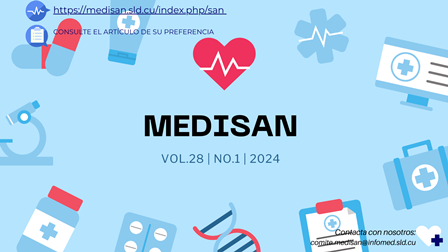Importance of immunohematological determinations in the prenatal control of pregnant women with RhD-negative blood group
Keywords:
pregnant women, blood group antigens, alloimmunization, fetal erythroblastosis, prenatal care.Abstract
The guide for prenatal care is the regulatory mark of obstetrics norms for the control and care of pregnant women, with emphasis on those who have the RhD negative blood group. Alloimmunization by anti-D is the most frequent and serious cause of hemolytic disease of the newborn. For an early diagnosis of the pregnant woman with said blood group, it is necessary to determine the red blood cell antibodies involved. This communication highlights the role of the immunohematology laboratory in the follow-up of pregnant woman with RhD negative blood type.
Downloads
References
2. Bi SH, Jiang LL, Dai LY, Zheng H, Zhang J, Wang LL, et al. Rh-incompatible hemolytic disease of the newborn in Hefei. World J Clin Cases. 2019 [citado 19/03/2023];7(20):3202-7. Disponible en: https://www.ncbi.nlm.nih.gov/pmc/articles/PMC6819308/
3. Alcocer Díaz S, Preciado Valencia HT, Zamora Llanos LF, Acebo Gutiérrez JM. Factor Rhesus. Manejo en el embarazo. Pol Con. (Edición núm. 62). 2021 [citado 19/03/2023];6(9):441-61. Disponible en: https://dialnet.unirioja.es/descarga/articulo/8094609.pdf
4. Ali Pérez NA, Matos Bayeau AA, Rodríguez Ruiz M. Reacción transfusional hemolítica retardada por aloanticuerpo anti-E. Rev Inf Cient. 2019 [citado 22/02/2022];98(1):98-105. Disponible en: http://scielo.sld.cu/scielo.php?script=sci_arttext&pid=S1028-99332019000100098&lng=es
5. Rivas G, Marcalain V, Recouso J, Silveira V, Bentos J, Alonso V, et al. Guía de manejo obstétrico y del recién nacido en madre aloinmunizada. Rev Méd Urug. 2021 [citado 19/03/2023];37(3):e801. Disponible en: http://www.scielo.edu.uy/scielo.php?script=sci_arttext&pid=S1688-03902021000301801&lng=es
6. Morales Vindas V, Picado Marín E, Córdoba Vives S, Fonseca Peñaranda G. Hidrops Fetal por aloinmunización RH tratado mediante transfusiones intrauterinas seriadas. Revista Clínica HSJD. 2020 [citado 19/03/2023];10(3):31-7. Disponible en: https://www.medigraphic.com/pdfs/revcliescmed/ucr-2020/ucr203e.pdf
7. Padoan A. Laboratory tests to monitoring physiological pregnancy. J Lab Precis Med. 2020 [citado 22/02/2022];5:7. Disponible en: https://jlpm.amegroups.org/article/view/5236/pdf
8. Álvarez Fumero R, Breto García A, Piloto Padrón M, Nápoles Méndez D, Del Rosario Pérez A, Pérez Valdés-Dapena D, et al. Guías de actuación en las afecciones obstétricas frecuentes. La Habana: Editorial Ciencias Médicas; 2017 [citado 22/02/2022]. p. 165-70. Disponible en: http://www.bvs.sld.cu/libros/guias_actuacion_afecciones_obstetricas/guias_%20actuacion_%20afecciones_%20obstetricas_completo.pdf
9. Águila Setién S, Nodarse Rodríguez A. Enfermedad hemolítica perinatal por isoinmunización Rh S. En: Rigol Ricardo O, Santisteban Alba SR, Cutié León E, Cabezas Cruz E, Farnot Cardoso U, Vázquez Cabrera J, et al. Obstetricia y ginecología. 3 ed. La Habana: Editorial Ciencias Médicas; 2014. p 393-402.
10. Matos Bayeau AA, Castellanos Martínez R. Laboratorio de Inmunogenética de Santiago de Cuba: paradigma en la prevención de la enfermedad hemolítica perinatal. MEDISAN. 2017 [citado 08/03/2022];21(6):650-1. Disponible en: http://scielo.sld.cu/scielo.php?script=sci_arttext&pid=S1029-30192017000600001&lng=es
11. Pérez AM, Hernández de la Fuente CL, Sánchez Martínez LJ, Calderón R. Antropología, genética y epidemiología del grupo sanguíneo eritrocitario Duffy. Un enfoque multidisciplinar. Rev Esp Antrop Fís. 2021 [citado 19/03/2023];(43):56-75. Disponible en: https://dialnet.unirioja.es/servlet/articulo?codigo=8381242&orden=0&info=link
12. Soler Noda G. Caracterización fisiopatológica de las anemias hemolíticas autoinmunes. Rev Cubana Hematol Inmunol Hemoter. 2022 [citado 26/03/2023];38(4):e1715. Disponible en: https://revhematologia.sld.cu/index.php/hih/article/view/1715/1401
Published
How to Cite
Issue
Section
License
All the articles can be downloaded or read for free. The journal does not charge any amount of money to the authors for the reception, edition or the publication of the articles, making the whole process completely free. Medisan has no embargo period and it is published under the license of Creative Commons, International Non Commercial Recognition 4.0, which authorizes the copy, reproduction and the total or partial distribution of the articles in any format or platform, with the conditions of citing the source of information and not to be used for profitable purposes.





